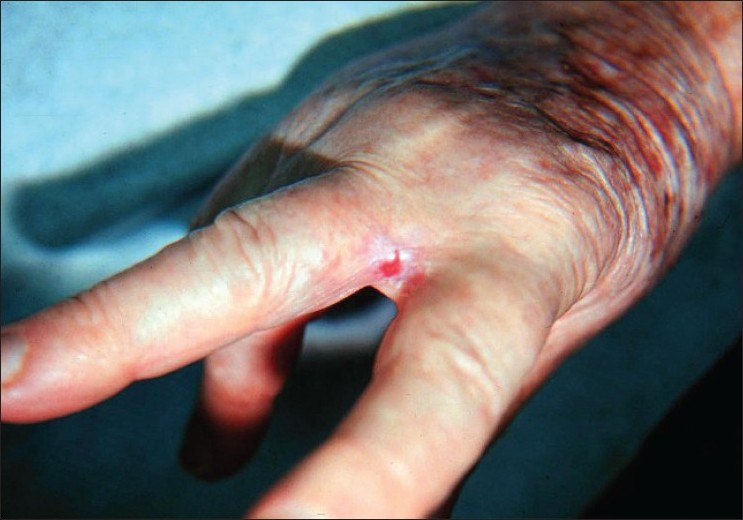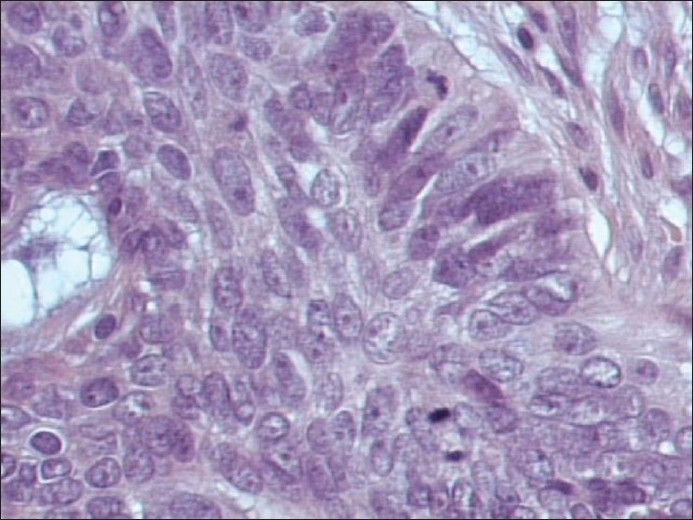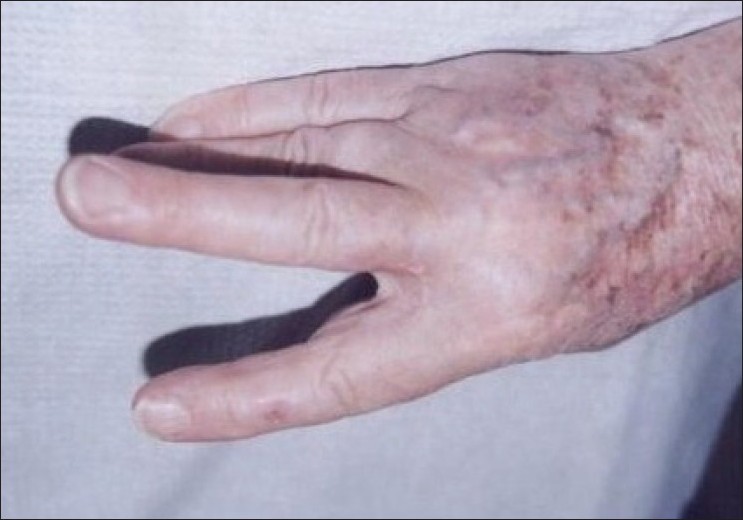Translate this page into:
Interdigital basal cell carcinoma of the hand: A rare site
Correspondence Address:
Efstathios Rallis
11 Pafsaniou Street, Athens, Greece, GR-11635
Greece
| How to cite this article: Rallis E, Nasiopoulou A, Arvanitis A. Interdigital basal cell carcinoma of the hand: A rare site. Indian J Dermatol Venereol Leprol 2010;76:593 |
Sir,
Basal cell carcinoma (BCC) is the most prevalent type of skin cancer in the white population, and it is the most common malignancy overall in humans. [1] It is usually seen on the face and neck area and approximately one-third of BCCs are found on other parts of the body. [2]
Although commonly occurred and thoroughly described, it seems that BCC rarely develops on the palms and soles. The interdigital space is considered the rarest location of this tumor. [3] Three cases of an interdigital pedal BCC have been reported [3],[4] but, to the best of our knowledge, this is the first case of an interdigital BCC of the hand.
A 63-year-old woman was referred to our department for evaluation of a 2-month history of an ulcerative lesion located at the second interdigital space of her right (dominant) hand [Figure - 1]. The lesion was well defined, approximately 0.7 cm in diameter and oval shaped. The floor of the ulcer was slightly depressed below the skin surface and had a fleshy appearance. There was no inflammation around the lesion. A pearly translucent border with thin superficial vessels was seen, rising above the normal level in a few areas. The patient stated that she underwent topical antibacterial and antifungal treatment for 1 month, which was unsuccessful. Her occupation as a farmer was taken under consideration.
 |
| Figure 1 : Rodent ulcer localized in the second webspace of her right hand |
A 3 mm punch biopsy was performed and differential diagnosis included BCC, pyogenic granuloma, candidiasis and impetigo. Mycologic and bacteriologic examination, including potassium chloride (KOH) preparation, Gram stain and cultures obtained from the ulcer, were negative.
The pathologic evaluation revealed a large number of cells with large, oval, deeply basophillic nuclei and scanty cytoplasm. The peripheral cells were arranged in characteristic palisades [Figure - 2]. The histological examination was compatible with basal cell carcinoma. Excision of the lesion was achieved via surgery and the defect was repaired with a full-thickness skin graft. Six months later, the surgical site healed with an excellent cosmetic and functional result [Figure - 3].
 |
| Figure 2 : A large number of cells with large, oval, deeply basophillic nuclei and scanty cytoplasm were seen, arranged in characteristic palisades (H and E, x400) |
 |
| Figure 3 : No recurrence and good cosmetic result was seen 6 months after the excision |
BCC most frequently occurs on sun-exposed and sun-damaged skin. It develops slowly and metastasis is exceedingly rare. The etiology of the tumor is still unclear, but exposure to UV radiation is the main pathogenic factor. [5] The predisposing factors for developing BCC include skin phototypes I and II, prolonged exposure to ultraviolet light, arsenic exposure, chronic ulcer/trauma, scars resulting from burns, former therapeutic radiation, immunodeficiency, vaccines, viruses, tattoos, family history of skin cancer, inherited syndromes such as albinism, nevoid basal cell carcinoma syndrome and xeroderma pigmentosum.
The dorsum and the nail unit of the hand and, less frequently, the palm, the inner digital cleft and the web, as in our patient, often endures sunburns, chronic and intermittent exposure to sunlight and chronic trauma. However, the hand is not considered a common site of BCC.
In our patient, the appearance of the tumor in a non-typically sun-exposed region as the interdigital space, which lacks pilosebaceous follicles and the absence of known predisposing factors, raises questions regarding the pathogenesis of this carcinoma. Perhaps, her occupation as a farmer and, subsequently, the traumas that frequently occurred in her dominant hand may have predisposed to the development of the tumor in this unusual site.
Although a number of extensive reviews of hand carcinomas have been reported, they lack specific tumor location. [6] It is obvious that more cases of BCCs in unusual sites and further etiologic investigation need to be considered in the evaluation of the pathogenesis of this tumor. Physicians should be aware of the development of BCCs in unusual sites such as the interdigital spaces.
| 1. |
Rao GR, Amareswar A, Kumar YH, Prasad TS, Rao NR. Pigmented basal cell carcinoma of the scrotum: An unusual site. Indian J Dermatol Venereol Leprol 2008;74:508-9.
[Google Scholar]
|
| 2. |
Zuuren Ej, Bastiaens MT, Posma AN, Bavinck JN. BCC on the dorsum of the hand: report of 11 cases. J Eur Acad Dermatol Venereol 2000;14:307-10.
[Google Scholar]
|
| 3. |
Abeldaρo AM, Tiscornia J, Cendeρo LP, Brea P, Chouela EN. Basal cell carcinoma in palm and sole. Skinmed 2006;5:40-2.
[Google Scholar]
|
| 4. |
Silvers SH. Interdigital Pedal BCC. Cutis 1983;31:199-206.
[Google Scholar]
|
| 5. |
Kumar N, Saxena YK. Two cases of rare presentation of basal cell and squamous cell carcinoma on the hand. Indian J Dermatol Venereol Leprol 2002;68:349-51.
[Google Scholar]
|
| 6. |
Bean DJ, Rees RS, O'Leary JP, Lynch JB. Carcinoma of the hand: A 20-year experience. South Med J 1984;77:998-1000.
[Google Scholar]
|
Fulltext Views
1,869
PDF downloads
1,072





